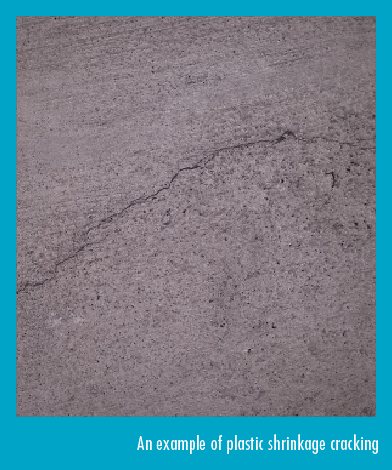How to avoid concrete cracking
13 Oct 2015, Building and housing, Featured, Prove Your Know How, Technical

With spring upon us, and summer around the corner, we are entering the high-risk period for early-age concrete cracking – this is the first in a two-part series on how to help prevent it
Higher daytime temperatures and dry winds, along with low evening temperatures, are a perfect recipe for concrete cracks.
If you want to minimise the time spent investigating and rectifying this issue, you need to understand the causes and preventative measures you can take to avoid problems. This article looks at cracks that form in concrete in its plastic state – after it has been placed, but before it has set.
Plastic cracking
The formation of cracks in concrete is inevitable and can form prior to the concrete setting, or after it’s in its hardened state. During the setting stage, the moisture content of the concrete changes and water is given off, hence the concrete shrinks. This shrinkage leads to a volume change, and, as concrete has a low tensile strength, cracks will form if the change is restrained. However, appropriate measures can eliminate, or at least minimise, the formation of these unwanted cracks.
Cracks that form before the concrete has fully hardened (usually not less than about eight hours) are known as plastic cracks. Plastic cracking occurs as either shrinkage cracks or settlement cracks.
Plastic shrinkage cracks
Once concrete is in place, evaporation can only occur from the free surface. In the absence of appropriate precautions, and in unfavourable drying conditions, the rate of evaporation at the surface can be greater than the rate at which water within the concrete can migrate to the surface to make good the loss. Sunny and/or windy days with low humidity levels pose the greatest risk of this situation occurring.
After concrete has been placed, vibrated, screeded and floated, it is left so the bleed water can rise to the surface. The slab cannot be finished until it is hard and the bleed water has evaporated. Bleed water appears within about 15 minutes of placing. The slab is then usually ready for finishing after several hours, depending on the concrete temperature. If the top surface is allowed to dry before final finishing, then plastic shrinkage cracking may occur.
The risk of plastic shrinkage occurring is greatest when:
- The temperature difference between the concrete and air temperature is large. In spring, this type of cracking can occur in an area exposed to the sun, while shaded concrete remains uncracked. Concrete exposed to the sun can be significantly hotter than the air temperature.
- Low bleed concrete mixes (eg, superplasticised mixes and/or mixes with high quantities of ultrafines) are used. The more concrete bleeds, the less likely it is that the surface will prematurely dry out. As such, greater precautions are required when using low-bleed concrete mixes.
- There is low humidity.
- There are high wind speeds.
What do plastic shrinkage cracks look like?
The cracks usually occur either during finishing, or up to six hours after, and form without any regular pattern. They may range from 25mm to 2m in length and can be straight or jagged. Cracks often intersect each other to form T-junctions or acute angles. They vary in width, from a hairline to perhaps 3mm. Additionally, while they are surface related, the cracks may extend deeper with subsequent drying of the slab.
How can plastic shrinkage cracking be avoided?
The most effective way to reduce the
risk of plastic shrinkage cracking is to prevent rapid loss of moisture from the surface of the concrete. Practices to achieve this are:
- Dampen the subgrade and formwork, while also ensuring any excess water is removed prior to placing concrete.
- In hot weather, lower the temperature of the fresh concrete by using cool aggregates if possible.
- Erect wind breaks to reduce wind velocity over the concrete surface.
- Use polythene sheets on the top surface of the concrete to prevent evaporation and air movement. (These should be used with caution though when trying to obtain
a consistent colour to the slab). - Use a proprietary evaporation retardant spray. These are inexpensive and provide a good degree of protection if used in accordance with the manufacturer’s instructions.
- Add polypropylene fibres to the concrete mix. The use of polypropylene fibres works by evenly distributing many small reinforcement fibres throughout the mass of the concrete in all directions and intersecting any micro-cracking that occurs when the concrete shrinks. Fibres are typically added at the batching plant and therefore their use requires planning. Your ready-mix concrete supplier will be able to advise you on the appropriate dosage.
- Commence curing promptly after finishing is complete, and ensure the surface is subject to continuous curing. Providing a fog mist spray to increase humidity above the concrete is a good means of achieving this, although may be difficult to get a uniform application during windy conditions. It’s important excess water is not added to the surface.
In the next issue, we’ll go over plastic settlement cracking and how to avoid it.
Register to earn LBP Points Sign in




